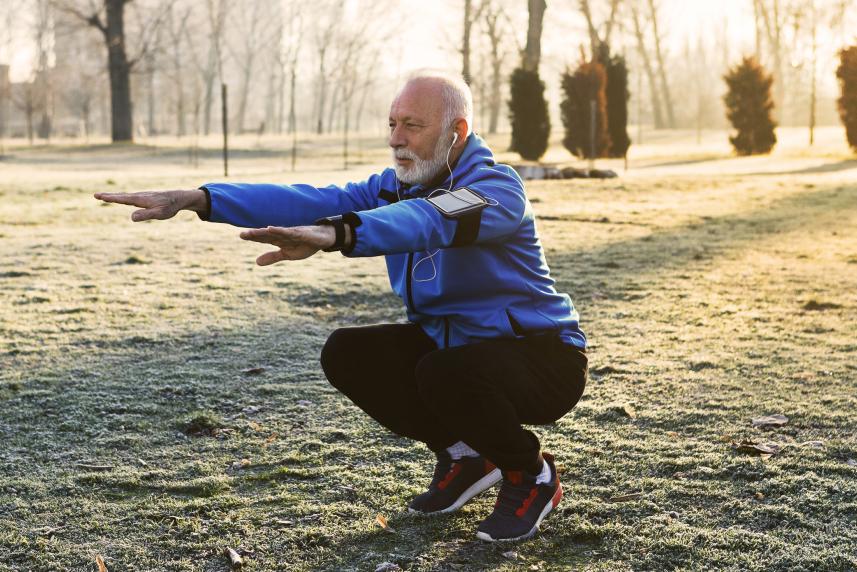Finding winter exercise motivation
Don’t let these seven common excuses for not exercising stop you in your tracks this season.

Winter is here, and for many people that means diminished exercise inspiration. Days with less sunlight, colder weather, and in many areas slush and snow can make being active a chore. So how can you motivate yourself to stay on track throughout the winter? Marilyn Moffat, a professor of physical therapy at New York University, is used to offering exercise encouragement during the winter months. Here, her advice about how to tackle seven of the most common reasons for not exercising—which, of course, are exacerbated at this time of year.
1. “I don’t have time.” This is the No. 1 reason people say they don’t exercise, Moffat says. But there are ways around it. One is to simply make half an hour of exercise part of your daily routine, the same as taking a shower or brushing your teeth. “You can do it first thing in the morning, then you don’t have to think about it for the rest of the day,” Moffat says. Also, try sneaking exercise into daily activities—park the car further away from the mall entrance to make yourself walk more (as long as it’s not too snowy!). Take the stairs instead of the escalator. Walk up and down one or two flights of stairs each day, and increase the numbers of flights over time. This gets you active and moving more, even if it doesn’t give you a full cardio workout.
2. “I don’t like exercising.” Maybe you don’t like aerobics classes, or you swim like an anchor, but if you’re persistent you will find something that appeals to you. “You need to like the activity, or you won't stick with it,” Moffat says. Dancing, volunteer work that requires walking—there are lots of activities that count as moderate exercise, even though they are not part of an exercise program. If you’re just starting to exercise, go slowly. Start in small bites and gradually work up to faster paces and longer times.
3. “I can’t stick with it.” One of the best ways to motivate yourself is to find a friend who is at a similar fitness level who also wants to work out. Bringing a friend along to your aerobics or dance class increases your sense of commitment. Another approach is to switch up routines and classes, since variety can make exercise more interesting. Do a dance class one night, yoga on another, and hit the indoor pool for laps on the weekend. Use a phone app to set goals and to remind yourself to get up and move more during the day.
4. “I don’t have the energy.” Feeling tired is a particularly persistent complaint during winter months. But guess what—there is a reward in regular activity. Becoming fitter means you’ll actually have more energy overall.
5. “I’m afraid I’ll get hurt.” Many people fear injuring themselves, especially as they get older. But cardiovascular exercise and muscle training are important for people of all ages. If you have a health condition that’s slowing you down, ask a physical therapist to help you develop a fitness program that will work for you. Many gyms offer exercise trainers, but “make sure you get someone who has the training and certification to give you a program that is appropriate and safe,” Moffatt says. Ask about credentials. You’ll want someone with the appropriate educational background (exercise science, physical education, exercise physiology, etc.) and certification in areas such as personal training, group exercise, and exercise physiology.
6. “I’m not coordinated enough.” Many people feel like they are too clumsy to participate in an exercise program. So start with something you know you can do, such as walking—then gradually go for brisker walks and greater distances. Also, Moffat says, “many exercise classes have programs for beginners. If you feel like you haven’t mastered it after a while, stay with the beginners. They often do many of the same activities as advanced classes, just at a lower level.”
7. “I can’t afford it.” Yes, joining a fitness club can be pricey, but there are lots of other activities without major out-of-pocket expenses. Walking, jogging, and jumping rope are all excellent low-cost ways to exercise. Some places, like the YMCA, have subsidy programs that can bring the cost of membership way down. And many community centers have equipment and pools that anyone can use.
How much exercise should I get?
Ideally, you should do at least 150 minutes of moderate aerobic activity a week, or a combination of moderate and vigorous activity. “Spread it out throughout the week. Try 30 to 40 minutes each day. Adding strength training exercises for the major muscle groups at least twice a week is important, along with stretching,” Moffat says.
Moderate exercise includes things like brisk walking and recreational swimming. Vigorous exercise includes swimming laps, running, and high-intensity aerobics.


